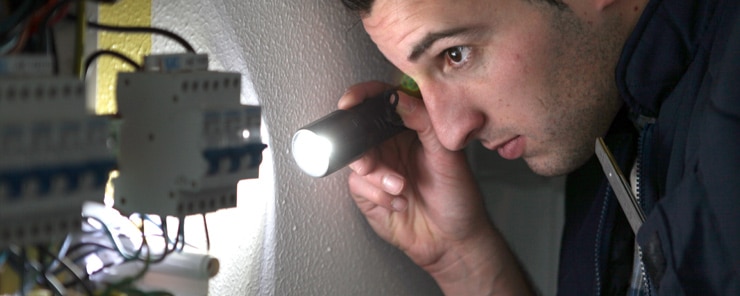Let’s face it, electricity, while awesome, is really confusing. Between AC and DC, volts, ohms, amps, and current, there is a lot of material to get mixed up. So why is it important for you to know the basics of electricity? Safety!
Ever wonder why it’s dangerous to get near power lines, but less to a wall outlet? Well to answer that question, you will need to know a little bit about the history and science behind electricity.
Edison vs. Tesla – Back near the turn of the century, inventors Thomas Edison and Nikola Tesla were fighting to have their form of electricity become the world standard. Edison, the noted inventor of the lightbulb, was trying to sell DC or “Direct Current”, while Tesla stood behind AC or “Alternating Current”
DC Power – This current flows in only one direction, keeping a constant voltage/current
AC Power – This current flows back and forth (at 60Hz, or 60 times a second), and is typically created by magnetism.
While DC power is the most useful of the two sources (AC power must be converted into DC in order to power much of today’s electronics), at the time their potentials were similar. The big difference came when Tesla invented the transformer. Unlike DC power, AC power can have its voltage and current changed.
You see, electricity dampens as it travels across a wire. In order for electricity to be sent across vast distances, it had to be sent at very high voltages with low currents. Because of AC’s ability to change between high and low voltage/current, it could be sent all over the globe, and safely transformed to a less dangerous charge upon arrival to its destination.
Fast forward to today – in the US, transformers lower the voltage from power wires to 120v, which is then pumped into your home. It enters your home through 2 live wires (and one natural ground wire), and connects to a fuse box.
Fuse box – This is the most important electrical component in your home. It is your first line of defense against dangerous power surges. The fuses are designed to flip the direction of charge once the voltage exceeds a fuses limit, protecting other devises down the powerlines for being damaged. Once the flip has occurred, the power is sent harmlessly into the earth, via the ground wire.
After the fuse box, electricity flows through parallel and series circuits.
Series Circuit – An electrical circuit with only one path for power to travel, like a string of Christmas lights. This is why some wall outlets only work if the light is turned on.
Parallel Circuit – An electrical circuit with several paths for power to travel, allowing power to continue past a resistor (electrical device) even if it is turned off.
If your fuse box is labeled correctly (it should be!!), you can shut down any circuit in your home by the flip of a switch. This is important to know as it makes any electrical work much safer! You should cut your fuses anytime you:
- Change a light switch
- Work on a wall outlet
- Inspect your ceiling lights/fans
While knowing these basics of home electricity can help with simple in home repairs and upgrades, it is always a good idea to speak with a professional whenever bigger problems arise. At Shockley, we have the expertise of licensed electricians and years of experience working with families in Georgia. If you have a power issue that you think might be too big for you to tackle alone, call us today!

